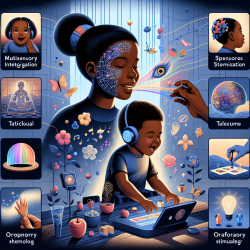Introduction
In the quest to improve therapeutic outcomes for children with Autism Spectrum Disorder (ASD), understanding the nuances of sensory integration is paramount. A recent study titled Audio–visual and olfactory–visual integration in healthy participants and subjects with autism spectrum disorder offers insightful revelations about multisensory integration (MSI) and its implications for therapy. This blog aims to distill the key findings from this research and explore how practitioners can leverage these insights to enhance their therapeutic approaches.
The Study at a Glance
Conducted by Stickel et al., the study utilized functional magnetic resonance imaging (fMRI) to examine the neural networks involved in olfactory–visual and auditory–visual integration in both healthy participants and individuals with ASD. The findings revealed that similar neural networks, including the primary visual cortex, inferior parietal sulcus (IPS), and medial and inferior frontal cortices, are engaged in both sensory integration processes. Notably, the amygdala was activated during olfactory–visual integration, while superior temporal activation was observed during auditory–visual integration.
Implications for Therapy
The study's findings underscore the importance of multisensory integration in therapeutic settings, particularly for children with ASD. Here are some actionable insights for practitioners:
- Incorporate Multisensory Stimuli: By integrating audio-visual and olfactory-visual stimuli into therapy sessions, practitioners can engage multiple neural pathways, potentially enhancing the child's sensory processing capabilities.
- Focus on the Inferior Parietal Sulcus (IPS): The study highlights the IPS's role in modulating sensory integration. Therapists can design activities that stimulate this area, such as tasks that require visual-spatial attention and coordination.
- Personalize Sensory Experiences: Since the study found no significant differences in MSI processing between ASD individuals and healthy controls, personalized sensory experiences tailored to each child's preferences and sensitivities could be beneficial.
Encouraging Further Research
While the study provides a robust foundation, further research is essential to deepen our understanding of MSI in ASD. Practitioners are encouraged to explore additional sensory modalities and their integration, as well as the long-term effects of multisensory therapy on neurodevelopment in children with ASD.
Conclusion
Multisensory integration holds significant promise for enhancing therapeutic outcomes for children with ASD. By embracing a data-driven approach and integrating the latest research findings into practice, therapists can create more effective and engaging therapy sessions. To delve deeper into the original research, please follow this link: Audio–visual and olfactory–visual integration in healthy participants and subjects with autism spectrum disorder.










